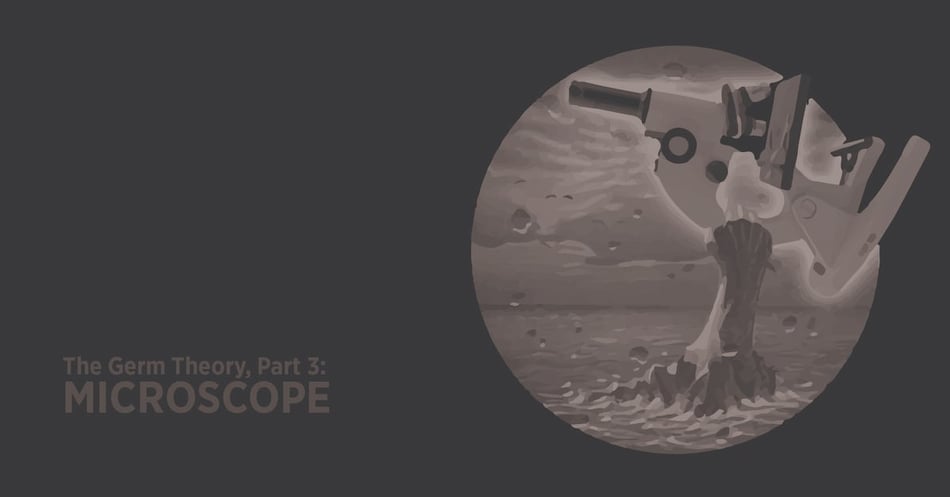
There is really no way to overstate the importance of Girolamo Fracastoro's bold proposal about the roots of infection. His idea that infections were caused by "seeds," living things unseen to the naked eye, was followed by deductions that included the spread of contagion, incubation periods, the organs affected by particular infectious agents, the vulnerable age for a particular disease, the idea that a survivor of an infection is protected against future infections, the ability of a disease to pass from mother to child through nursing, and many other valuable observations. His genius, while respected and supported, was not definitively proven until over 100 years later, with the advent of the microscope.
Optics and lens-making developed quickly in 16-17th century Europe, allowing research to expand to the universe. But just as lenses could sharpen light from far away, allowing Galileo to see Jupiter's moons, it could also magnify objects right in the laboratory. The microscope was invented by several lens makers at around the same time in the late 1500s and the technology spread throughout Europe. In the 1660s, however, the use of microscopes for intense research grew explosively. Discovery after discovery began to lay the groundwork for modern biology.
One such researcher, Danish trader and scientist Antonie van Leeuwenhoek, became rather obsessed with making better and better microscope lenses. He first became interested in magnification in order to see the quality of the textiles he sold as a draper. However, his lenses were of such superior quality that he arose the interest of the Royal Society, an association of researchers and scientists. Over the length of his impressively long career as an amateur scientist (70 years!), he wrote hundreds of letters to the Royal Society, describing his discoveries. (He never revealed how he made his lenses, however.)
Like his contemporaries, including the eccentric Athanasius Kircher (inventor of the Cat Organ), Leeuwenhoek turned his optics to the natural world, including rain and river water. There he saw hundreds of tiny creatures in different shapes, moving... living. As he improved upon his lenses, his descriptions of these animalcules become more detailed. The first recorded observation of bacteria comes from Leeuwenhoek, who used his tiny microscope (see image for scale) to examine his dental plaque. As he would describe in a letter after duplicating the same findings with other samples, he saw
"an unbelievably great company of living animacules a-swimming more nimbly than any I had ever seen up to this time...There are more animals living in the scum on the teeth in a man's mouth than there are men in a whole kingdom." (1683)*
While other researchers had published discoveries of tiny "worms" or "creatures" in water and blood samples, Leeuwenhoek's microscopes were the first to be strong enough to identify them as single-celled organisms. Thus was born the field of bacteriology.
Building upon Leeuwenhoek's discoveries, numerous scientists made explosive progress, discovering the organisms that helped ferment wine, break down rotting food, and most incredibly, cause disease. Within a century, the organisms responsible for leprosy, malaria, tuberculosis, cholera, diptheria, typhoid, and even the plague were discovered. Following their discovery, research could more successfully work towards treatments and cures, alongside prevention and protection.
* Leeuwenhoek was absolutely correct. There are an estimated 7 billion humans on Earth today, and an estimated 20 billion bacteria in a single human mouth.
These great scientists brought us into the modern age of medicine, one where we can treat our illnesses with antibiotics, prevent others with vaccines, and live decades longer in better health. With the same zeal these early scientists used, contemporary researchers are examining even more effective ways at combatting and preventing disease, including ways to prevent antibiotic resistance and unnecessary infections. It will be exciting to see what the future holds!
Editor's Note: This post was originally published in October 2015 and has been updated for freshness, accuracy and comprehensiveness.
![EOScu Logo - Dark - Outlined [07182023]-01](https://blog.eoscu.com/hubfs/Eoscu_June2024/Images/EOScu%20Logo%20-%20Dark%20-%20Outlined%20%5B07182023%5D-01.svg)

![[infographic] The Golden Age of Microbiology Download and share!](https://no-cache.hubspot.com/cta/default/216314/interactive-178321572618.png)



